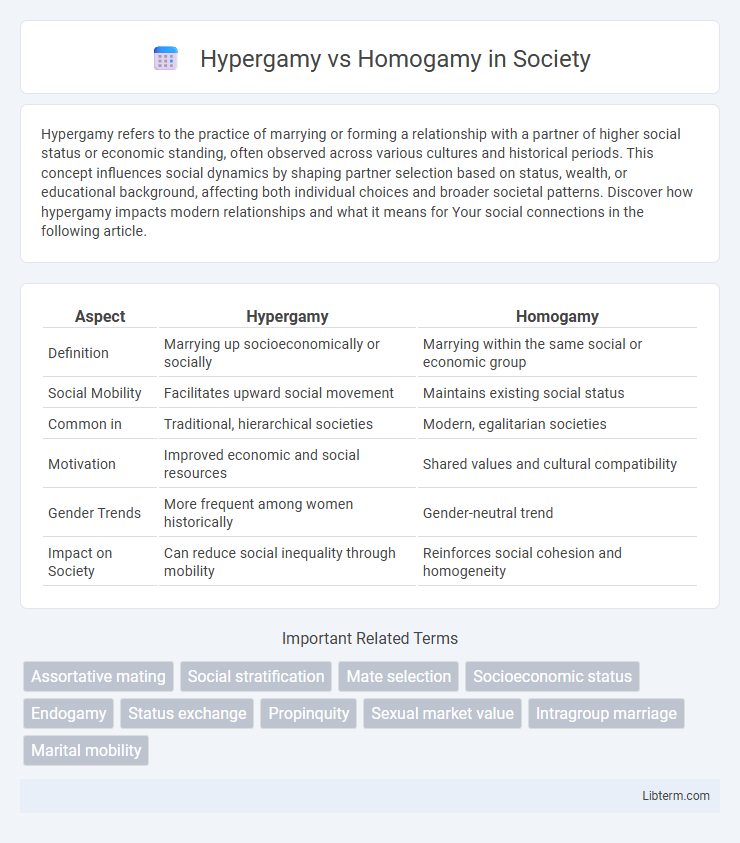Hypergamy refers to the practice of marrying or forming a relationship with a partner of higher social status or economic standing, often observed across various cultures and historical periods. This concept influences social dynamics by shaping partner selection based on status, wealth, or educational background, affecting both individual choices and broader societal patterns. Discover how hypergamy impacts modern relationships and what it means for Your social connections in the following article.
Table of Comparison
| Aspect | Hypergamy | Homogamy |
|---|---|---|
| Definition | Marrying up socioeconomically or socially | Marrying within the same social or economic group |
| Social Mobility | Facilitates upward social movement | Maintains existing social status |
| Common in | Traditional, hierarchical societies | Modern, egalitarian societies |
| Motivation | Improved economic and social resources | Shared values and cultural compatibility |
| Gender Trends | More frequent among women historically | Gender-neutral trend |
| Impact on Society | Can reduce social inequality through mobility | Reinforces social cohesion and homogeneity |
Understanding Hypergamy and Homogamy
Hypergamy refers to the practice of seeking a partner with higher socioeconomic status, education, or social standing, often observed in traditional mate selection patterns. Homogamy involves choosing a partner with similar characteristics such as background, values, education, or social class, promoting compatibility and shared life goals. Understanding these concepts provides insight into relationship dynamics, social mobility, and cultural influences on partner preferences.
Historical Context of Hypergamy and Homogamy
Hypergamy, historically rooted in patriarchal societies, denotes the practice of marrying into a higher social or economic class, often reinforcing social hierarchies and gender dynamics. Homogamy, by contrast, represents unions between individuals of similar social, economic, or cultural backgrounds, promoting social cohesion and stability. Both practices have been influenced by factors such as class structure, economic systems, and cultural norms throughout history.
Sociological Perspectives on Mate Selection
Hypergamy, the practice of seeking a partner of higher socioeconomic status, reflects societal structures that influence mate selection through power dynamics and social mobility aspirations. Homogamy emphasizes partner choice based on similarity in socioeconomic status, education, ethnicity, or values, reinforcing social cohesion and cultural continuity. Sociological perspectives highlight how hypergamy can perpetuate inequality, while homogamy supports social stability by maintaining established social networks and class boundaries.
Psychological Drivers Behind Partner Choice
Hypergamy involves selecting a partner with higher social or economic status, driven by psychological factors such as the desire for resource security and social mobility. Homogamy reflects preference for partners sharing similar traits, including values, education, and cultural background, fostering compatibility and emotional stability. These psychological drivers influence mate selection strategies by balancing aspirations for upward mobility with the need for shared understanding.
Economic Factors Influencing Relationships
Economic factors significantly shape hypergamy and homogamy by influencing partner selection based on financial stability and social status. In hypergamy, individuals often seek partners with higher income or socioeconomic status to enhance economic security and social mobility. Homogamy reflects a preference for partners with similar economic backgrounds, promoting mutual financial understanding and reducing economic conflicts within relationships.
Gender Roles in Hypergamous and Homogamous Unions
Hypergamous unions often reinforce traditional gender roles, where one partner, typically the male, holds higher socioeconomic status or education, emphasizing a dynamic of provider and caregiver. In homogamous unions, partners share similar social, economic, and educational backgrounds, promoting more egalitarian gender roles and mutual decision-making. Studies indicate that homogamy correlates with increased gender role flexibility, while hypergamy sustains conventional expectations within relationships.
Cultural Differences in Mating Preferences
Cultural differences significantly influence hypergamy and homogamy by shaping mating preferences through societal norms and values. In collectivist cultures, homogamy is often prioritized as it reinforces social cohesion and familial approval, whereas individualistic cultures may exhibit higher tendencies toward hypergamy, valuing upward social mobility and personal achievement in partners. Studies reveal that educational attainment and economic status play pivotal roles in these mating patterns, with hypergamy more prevalent in societies with pronounced gender role expectations.
Impact on Marriage Stability and Satisfaction
Hypergamy, the practice of marrying someone of higher socioeconomic status, often leads to increased financial stability but may cause challenges in emotional compatibility, impacting marital satisfaction. Homogamy, marrying within similar social, cultural, or economic backgrounds, tends to enhance communication and shared values, promoting higher marriage stability and long-term satisfaction. Studies indicate that homogamous couples report stronger emotional bonds and fewer conflicts compared to hypergamous relationships, which may face stress from status disparities.
Modern Trends in Dating and Relationships
Modern trends in dating reveal a nuanced shift where hypergamy--partnering with someone of higher socioeconomic status--coexists with homogamy, the preference for partners with similar cultural or educational backgrounds. Digital dating platforms emphasize compatibility algorithms that often prioritize homogamous traits like shared interests and values, while economic uncertainty reinforces hypergamous tendencies as individuals seek financial stability. Emerging research indicates younger generations balance these dynamics by valuing emotional connection alongside socioeconomic factors, reflecting evolving societal norms in relationships.
Future Implications for Society
Hypergamy, the practice of marrying into a higher socioeconomic status, may intensify social stratification and limit social mobility, while homogamy, marrying within similar social or economic groups, tends to reinforce existing social cohesion but can perpetuate inequality. Shifts toward homogamous relationships could solidify cultural and economic homogeneity, potentially stalling diversity and innovation in communities. Future societal dynamics will depend heavily on how educational and economic policies influence these mating patterns and their impact on social equality.
Hypergamy Infographic

 libterm.com
libterm.com